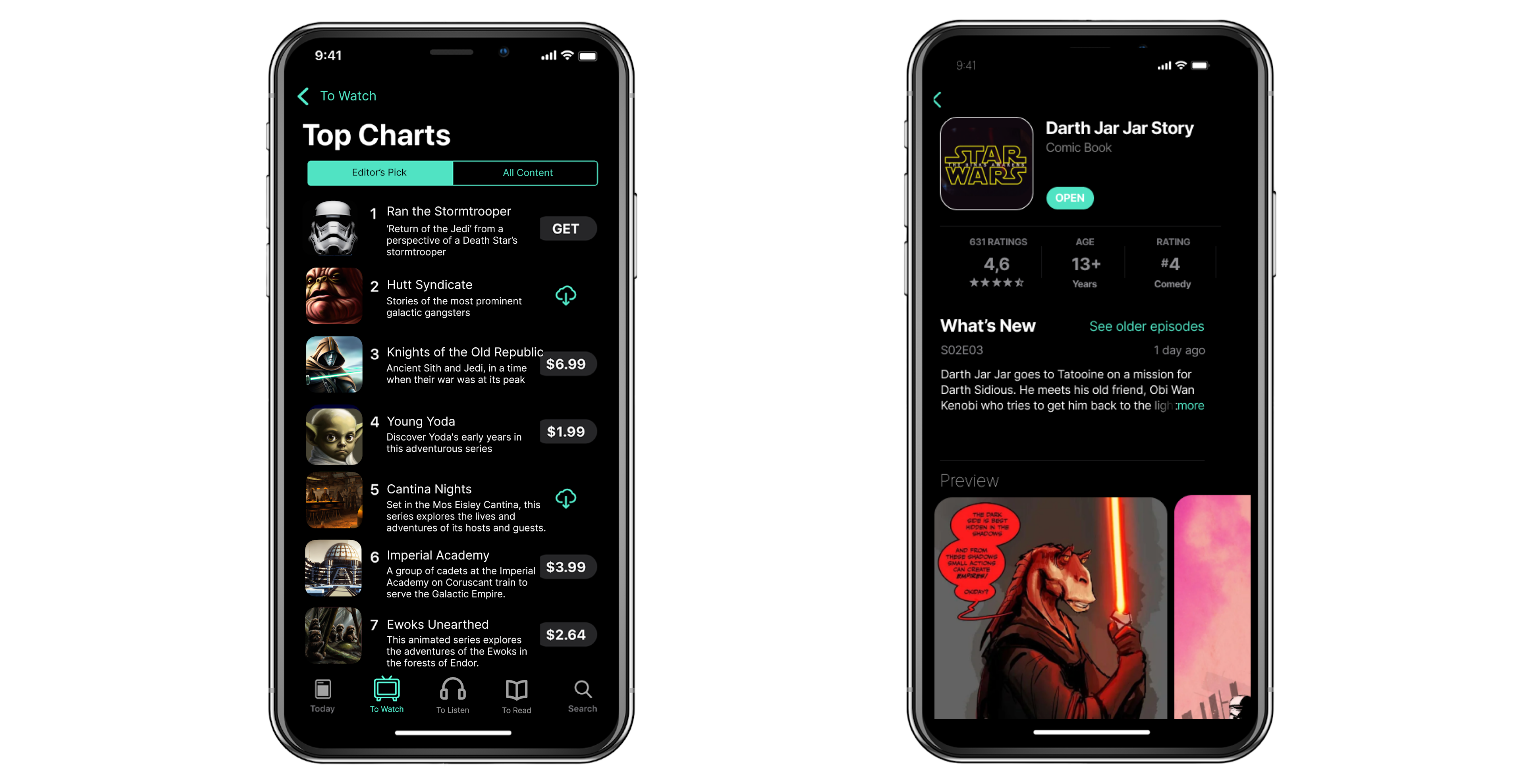This is Part III of the IP Protocols series.
In Part I, we introduced the concept of "IP Protocols" and explored different protocol designs - you can read Part I here. In Part II, we focused on the limitations of the current content creation models and proposed a way to solve them - you can read Part II here.
If you're new here, you're welcome to subscribe:
I believe that the next Disney will be built as a network of IP Protocols. Creators will be able to create their movies, games, and stories on top of these Universes without asking anyone for permission, so the worlds will be expanded and remixed in a bottom-up manner.
This endless stream of new ideas and content will satisfy even the most niche, longest-of-tails needs of the audience. Even better than the current, more top-down models.
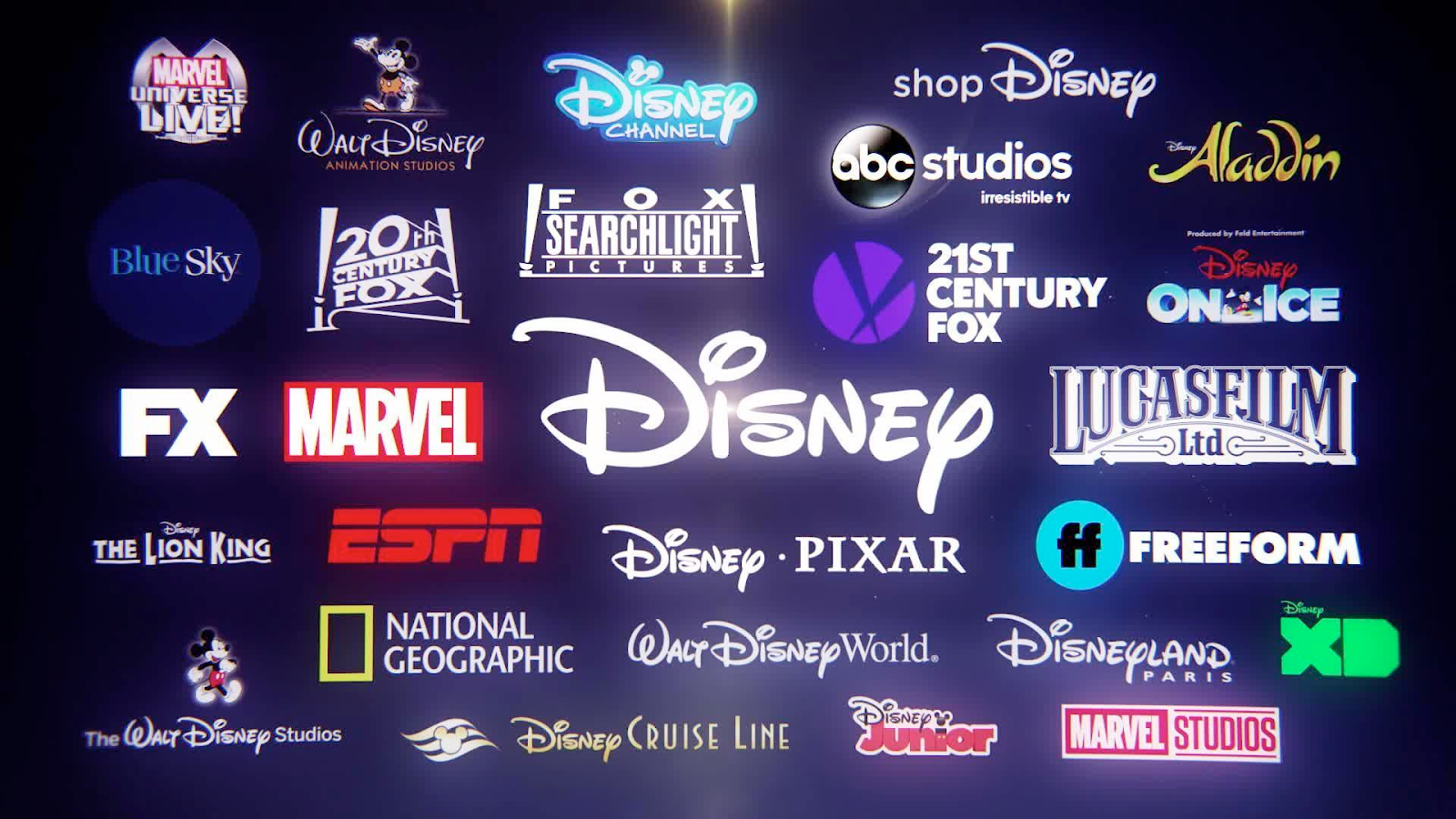
Some of the IPs owned by Disney (source)
We have already seen this mechanism in NounsDAO, though - at least for now - the scope of their creations is of a different kind. The closest example of a strong brand built on top of NFTs is Yuga Labs - creators of Bored Ape Yacht Club, who last year also bought Cryptopunks IP.
Their projects are many times smaller than those owned by Disney, but their community is very prolific.
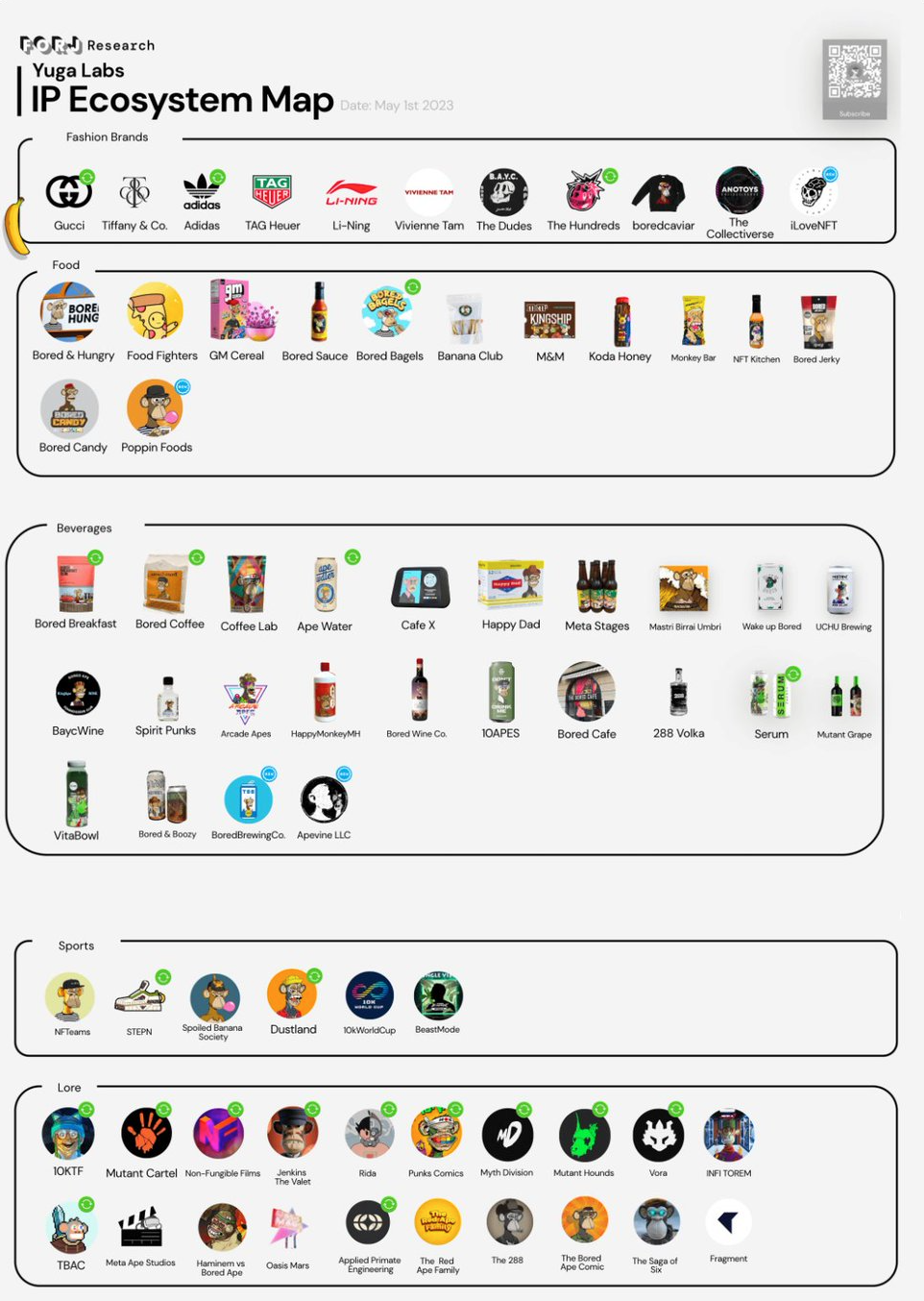
Some of the IPs and brands that are owned or cooperate with Yuga Labs (source)
Following the permissionless path will, of course, mean facing new risks and challenges. But it doesn’t mean that the Universe needs to descend into chaos.
AppStore has shown us ways to curate the best content from over 1.6 mln apps. Ethereum Foundation has paved the way for running an organization that keeps the balance between a visionary leader and an independent community. And NFTs have given us a glimpse at how creators could monetize their work.
How exactly could we build a permissionless IP Protocol from the ground up?
Here is my half-baked idea of the process that authors might follow to make this vision come true.
Step 1: Define how much permissionless you want for your IP protocol
Permissionlessness is a spectrum, and all design decisions at this stage have their pros and cons. That’s why it’s good to look at the models already explored by tech and choose the one that fits the author’s vision.
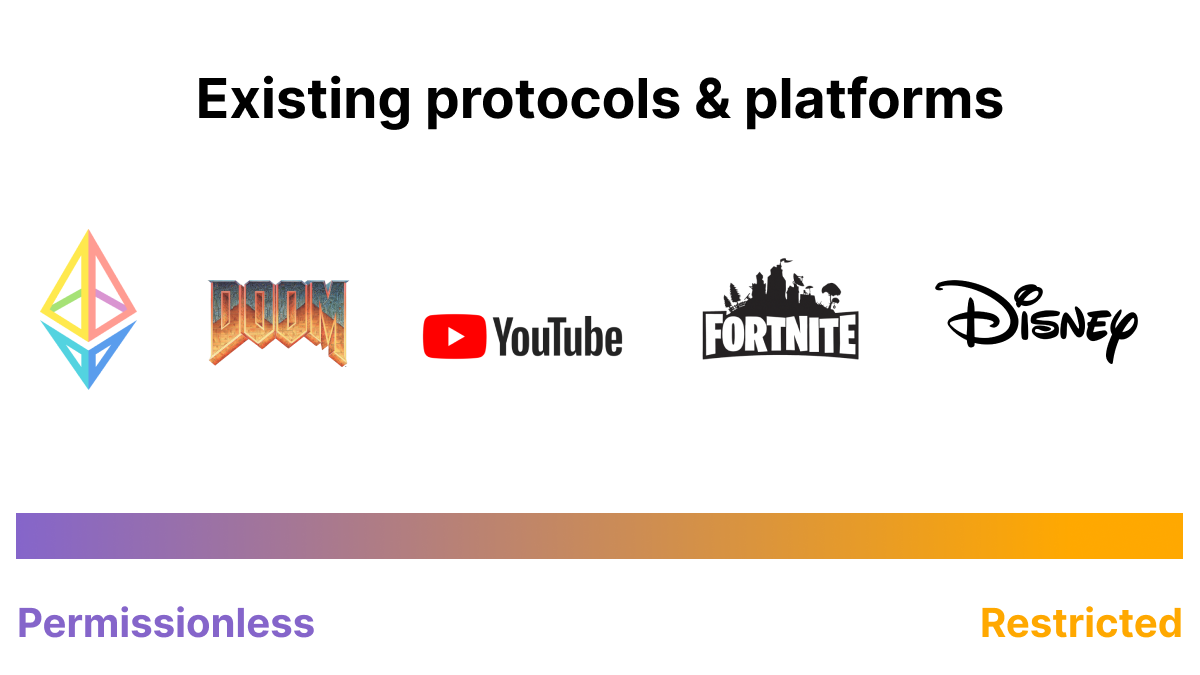
My personal sweet spot might be somewhere between YouTube and the DOOM model. For younger readers - DOOM is a 90s game created by id software that was famous for opening itself to user-generated mods that changed the gameplay. We even quoted a DOOM story in Part II.
So getting back to the point - in this model, everyone can create whatever they want. And they can integrate that without any permission. But this creative chaos is balanced by the list of recommendations curated by original creators & the community and is supplemented with user 5-star or like/dislike reviews.
Step 2: Define the basic rules guiding the world
This part is the core of IP Protocol building.
One thing is choosing the genre - a detective story, horror, or sci-fi movie. But you also need to set rules that will define how the world will look. Molding the world to fit your vision but also keeping it open enough to allow experiments is not an easy task.
These could be initial vectors to consider with some examples we discussed before:
Time (sci-fi future, medieval fantasy, today),
Place (Universe, alternative world, Earth)
Superpowers (force, magic, mutations),
Props (lightsabers & X-Wings, magic wands & rings of power, Iron Man suit & Infinity Stones),
Good & Evil (Jedi vs. Sith, Sauron vs. Elves, Avengers vs. Thanos),
Tone (Optimistic, Pessimistic, Adventurous)
Bear in mind that every genre has its own different twists. James Bond is a different spy series than Mission Impossible. Avengers are a different superhero series than X-Men. Game of Thrones is a different fantasy than Lord of the Rings.
So it’d be good to decide which path you want your protocol MVP to follow.
Step 3: Create an MVP
Star Wars hasn’t won the hearts of millions of fans by publishing the Dungeons & Dragons-like rulebook. It did that with a movie. You also should let people feel and experience your world in action.
Writing a book or shooting a Hollywood movie is an extremely time-consuming project, so it’d probably make more sense to start with something much smaller.
These IP Protocol MVPs can take many shapes and forms.
a) Detailed description of your characters
Interesting characters lead the story and captivate the audience.
Think about the confusing evilness of Joker, the dark authority of Darth Vader, or the witty playboy-ish manner of Iron Man. Without these characters, the movies wouldn’t be the same.
So the most basic MVP could be just detailed descriptions of your characters. We could start with their appearance, core motivations, backstory, beliefs, strengths, and weaknesses.
Sometimes distinct characters are enough to create a compelling story. RPG system called “Burning Wheel” creates engaging role-plays by precisely defining characters’ beliefs and traits and clashing them with the reality around them.
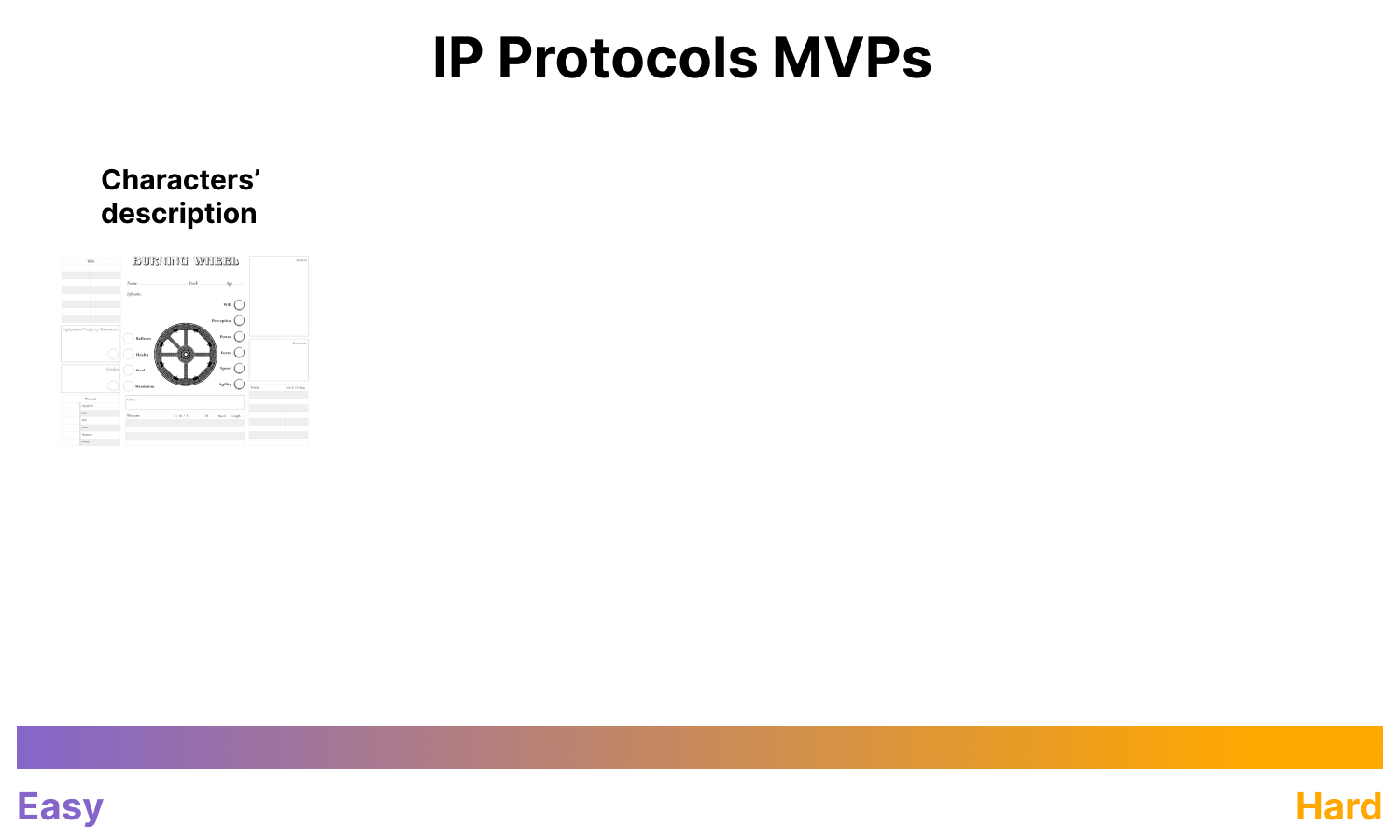
You can summarize Burning Wheel characters on one sheet of paper
b) Concept Art
Concept Art can let people feel the world we’re creating.
Think about the gray and solemn scenes from Witcher, futuristic Star Trek spaceships, or black Neo outfits. These visual elements define the tone of the story.
We could generate them as sketches, animations, or AI-generated pictures.
Sometimes Concept Art can be the start of something big. Angry Birds famously started in 2009 from a picture of a bird drawn by Jaakko Iisalo, Rovio’s game designer.
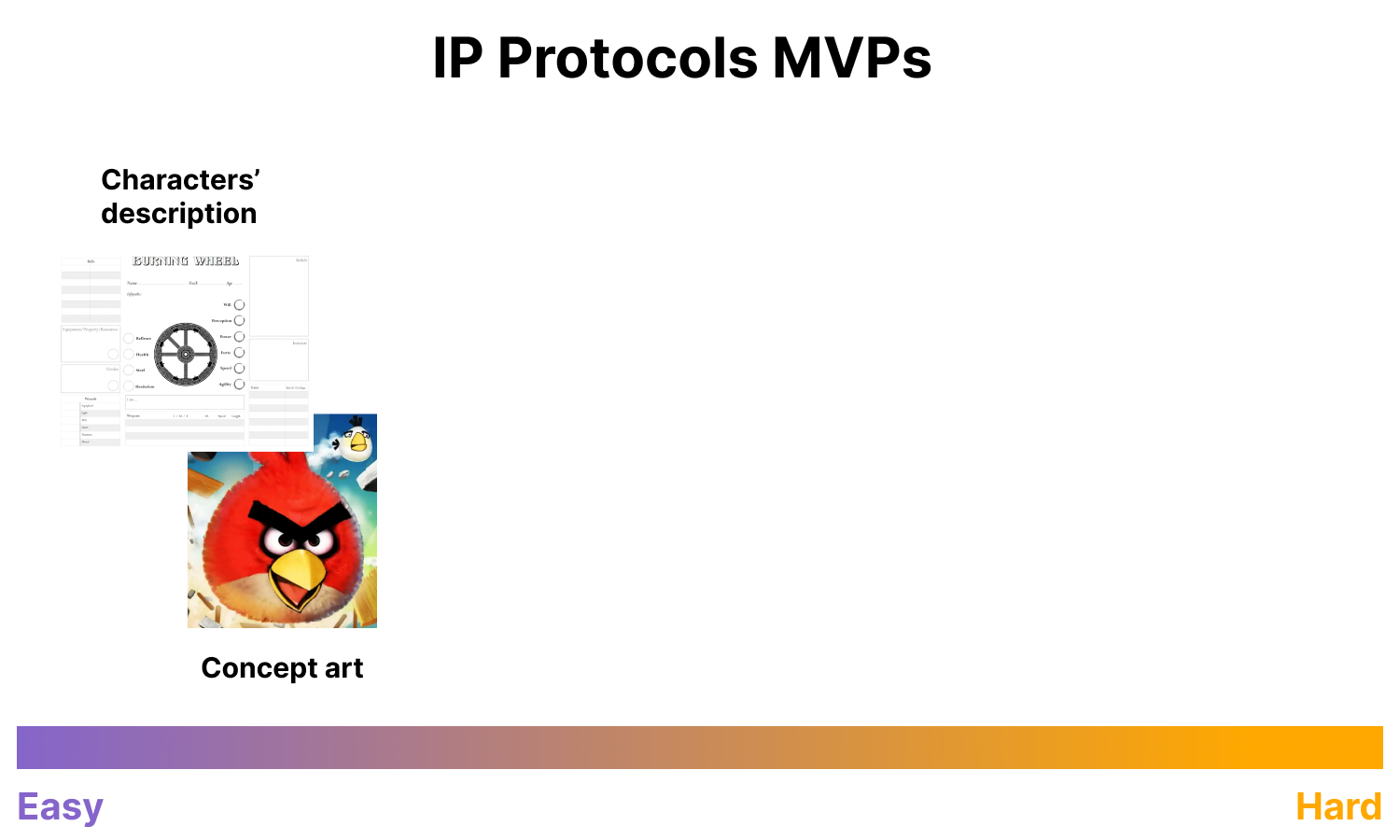
c) Short story
Short stories give the audience a detailed look into the world we’re creating.
They are like long trailers that let us understand in practice not only the IP Protocol’s characters but also their surroundings.
G.R.R. Martin also thinks that it’s a good playground for aspiring writers:
Given the realities of today’s market in science fiction and fantasy, I would also suggest that any aspiring writer begin with short stories. These days, I meet far too many young writers who try to start off with a novel right off, or a trilogy, or even a nine-book series. That’s like starting in at rock climbing by tackling Mt. Everest. Short stories help you learn your craft.
They are a good place for you to make the mistakes that every beginning writer is going to make. And they are still the best way for a young writer to break in, since the magazines are always hungry for short SF and fantasy stories. Once you’ve been selling short stories for five years or so, you’ll have built up a name for yourself, and editors will start asking you about that first novel.
Since it’s hard to predict what should all the Protocol’s rules look like before you build it, short stories might be a great playground to further define your characters, check how they interact with each other, and precise your IP Protocol’s rules.
The Witcher Universe, now famous for its books, games, and Netflix TV Series, started as Andrzej Sapkowski’s short story in 1986.
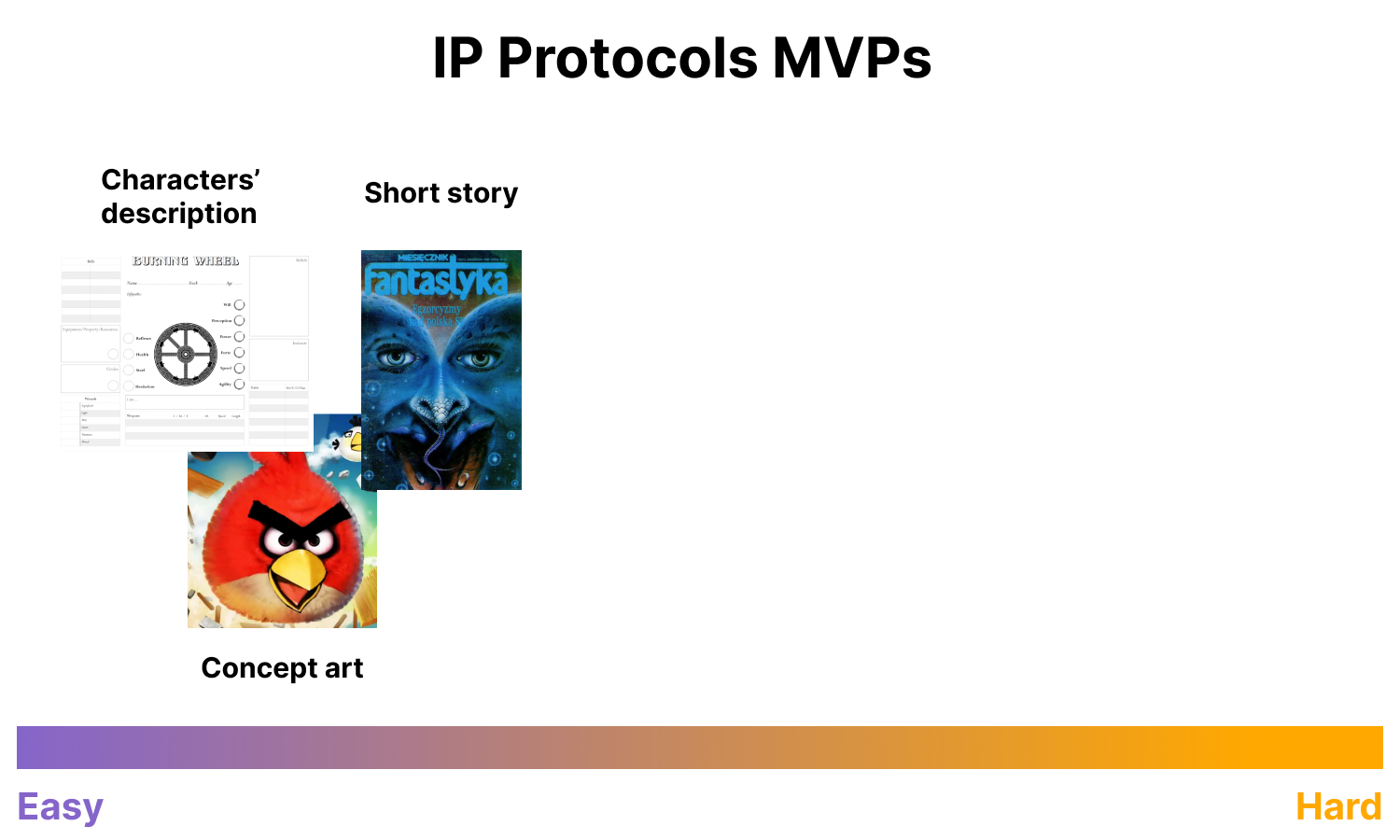
Cover of the “Fantastyka” magazine, where the first Witcher short story was published
d) Comic book.
The step further is the comic book which is a mix between concept art and a short story.
We not only define the plot and rules of the world but also decide how the world and characters will look. This is how MARVEL started its superhero journey.
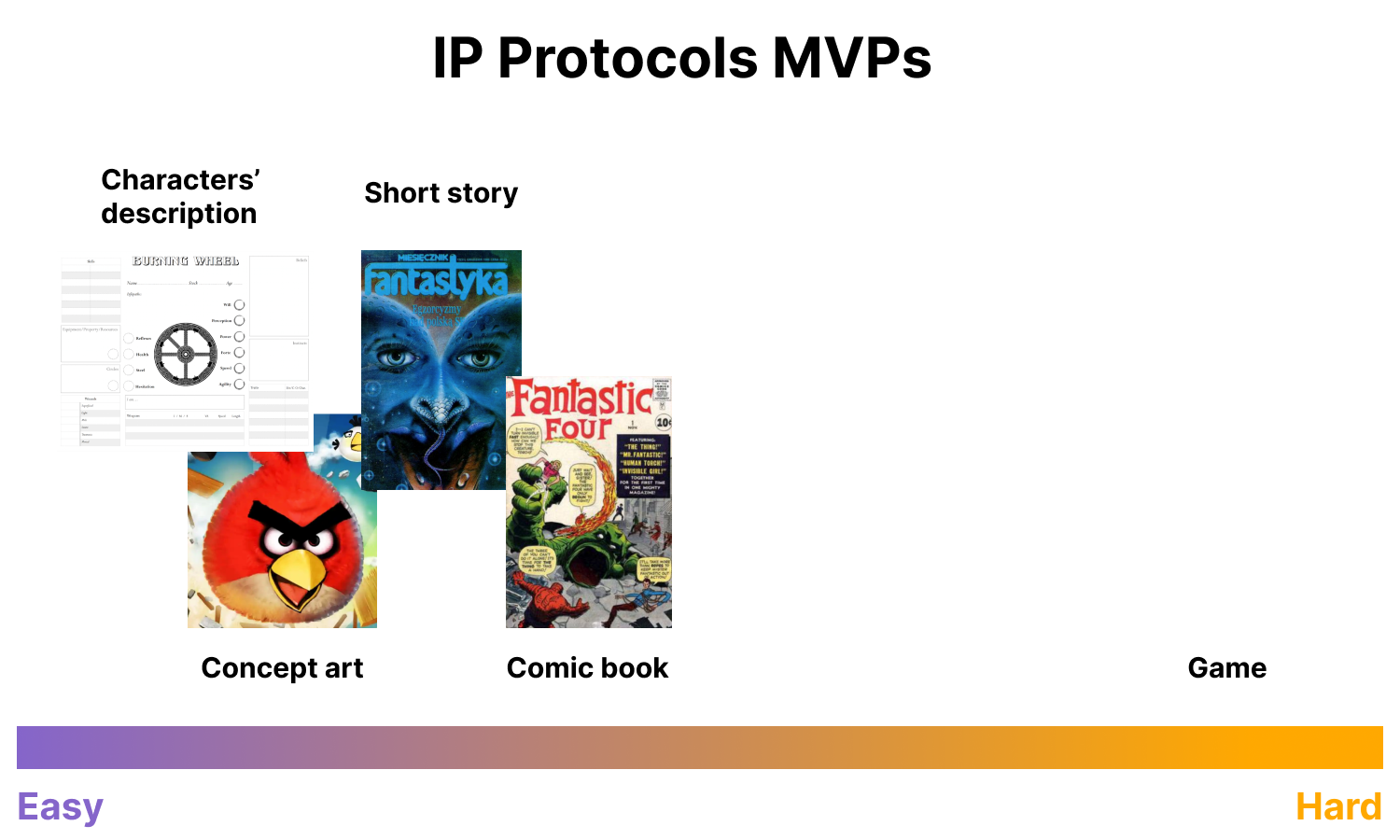
Cover of the first MARVEL superhero comic book by Stan Lee
d) Novel
A much bigger project would be writing a novel. It’s not only time-consuming, but it’s also just harder - we’d need to think about story arcs, character development, and the plot to cover 300+ pages.
It’s not an easy feat. Even J.R.R. Tolkien - Satoshi Nakamoto of fantasy - hasn’t started with Lord of the Rings. His first book was a much shorter and less complicated Hobbit.
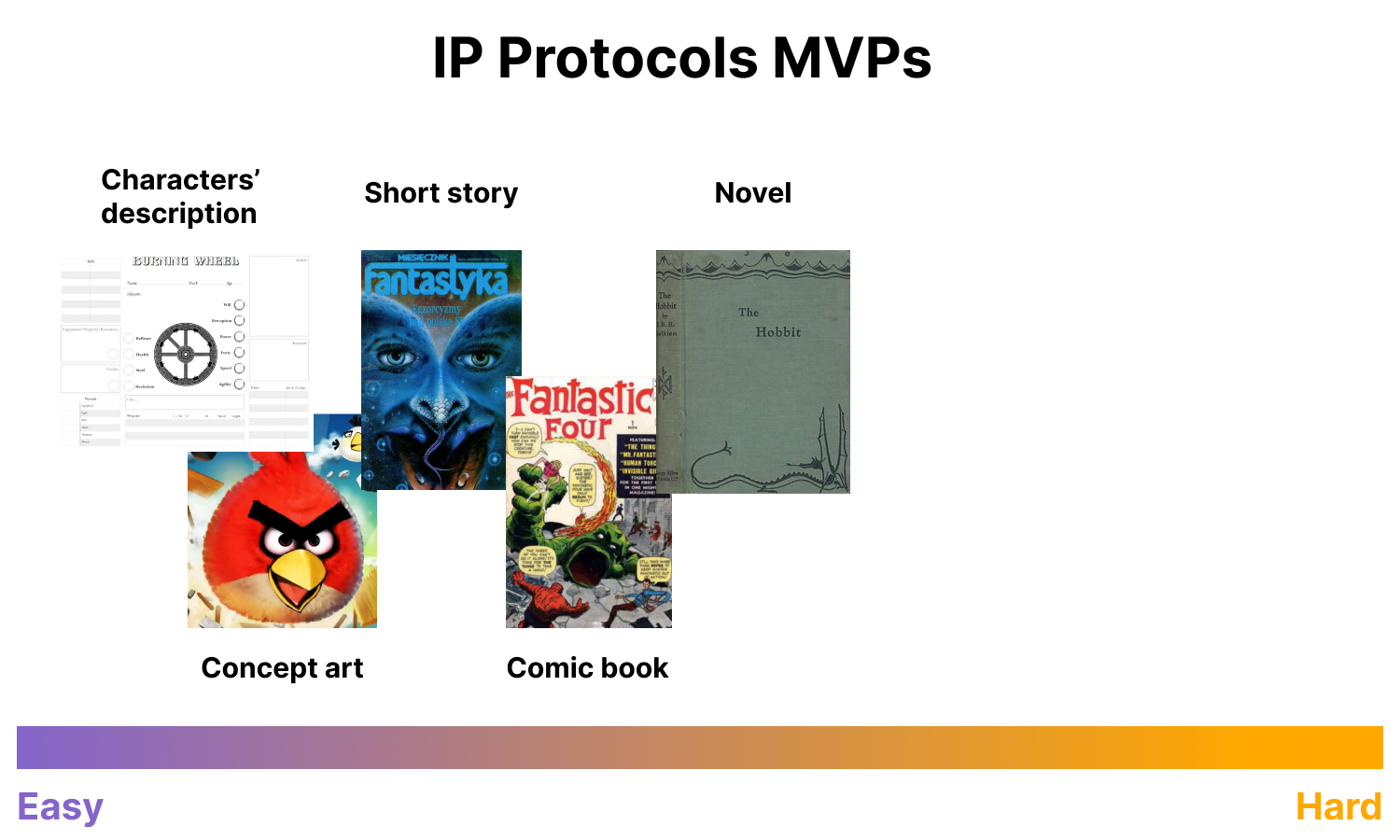
e) Animation
If we combine books with concept art and add movement, we get animation. It can be a big and expensive project, but it can win people’s hearts.
Although I wouldn’t advise starting with 90+ minutes long animation, that’s how Toy Story started its franchise in 1995.
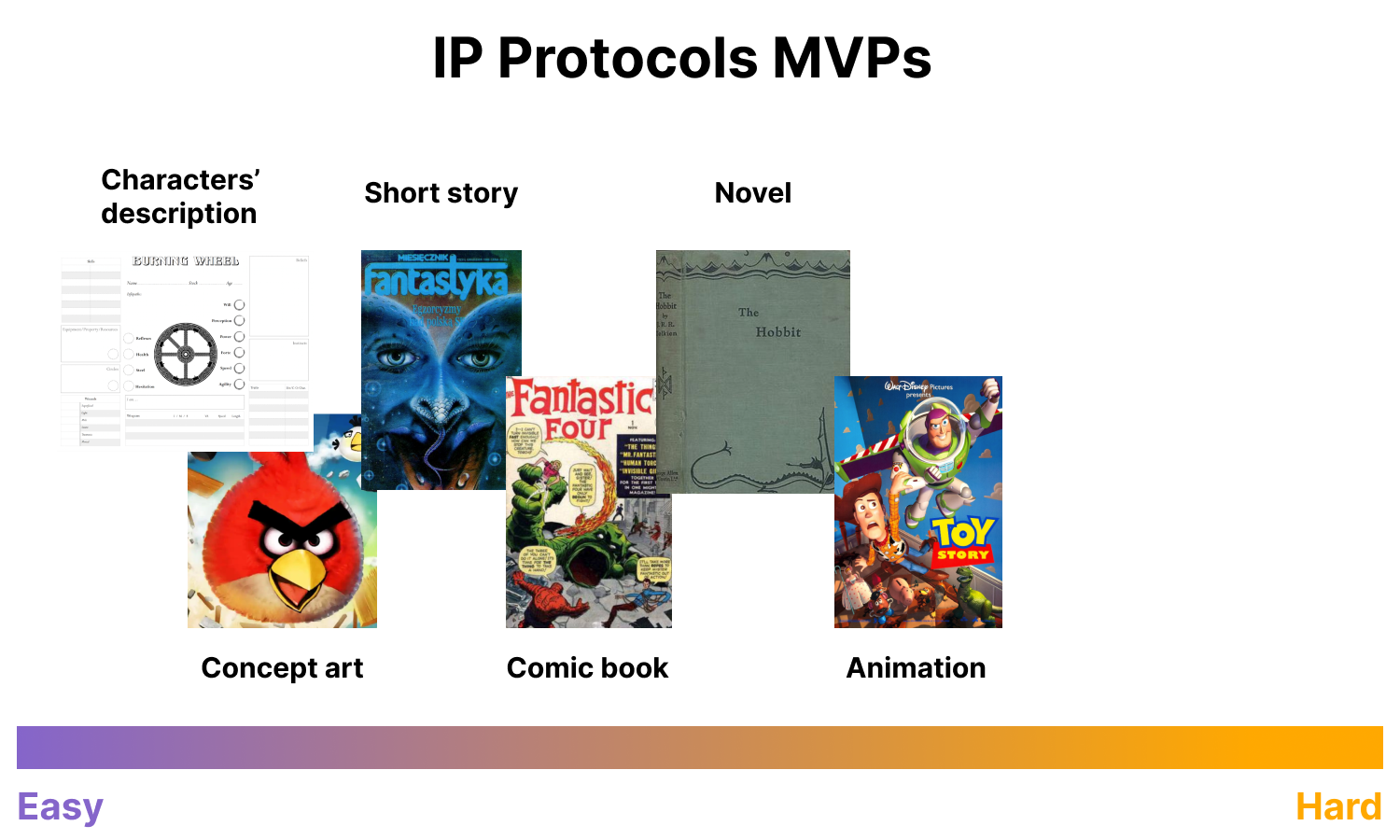
f) Movie
If we have enough money (and patience), we can also decide to produce a movie. Although Star Wars started this way in 1977, it’s a pretty advanced project, so it’d be better to keep it for the later stages of Universe development.
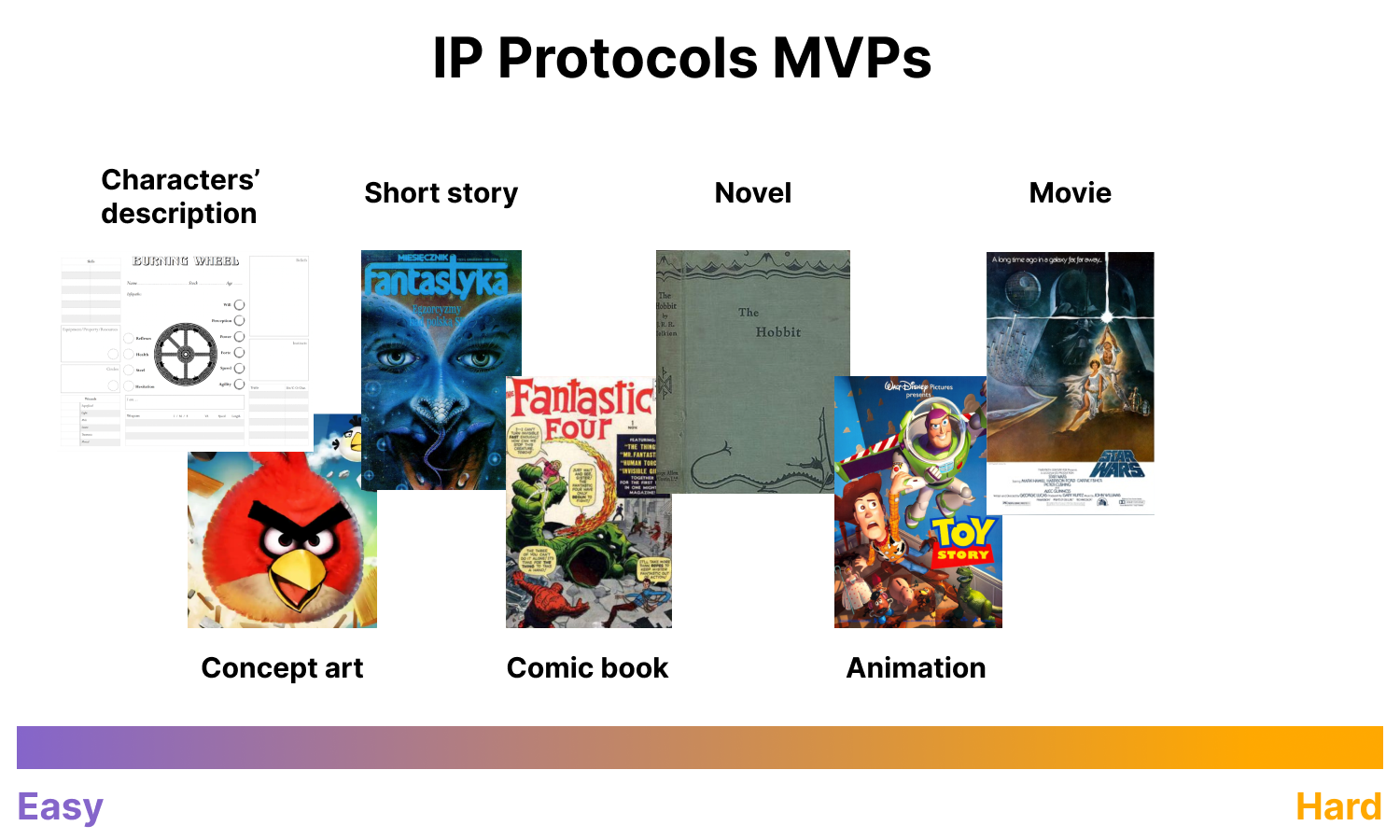
g) Game
The last - and the hardest - thing to do is a game. Of course, we can create small games just like we can create short animations and movies. Who knows, maybe we will create the next Flappy Bird or Angry Birds.
Regardless of our scope, it’s just super hard to create a good game. Experienced studios spend hundreds of millions of dollars every year and still publish flops like Fallout 76.
That’s because, on top of the storytelling part, you also need to crack the game mechanics, which is much harder. So I’m very skeptical whenever I see an NFT pfp project that wants to build a game - it’s as if you skipped all smaller MVPs and started to tackle the hardest project first.
But it can work. That’s how League of Legends was born in 2009 and expanded into the TV series world with its excellent show Arcane.
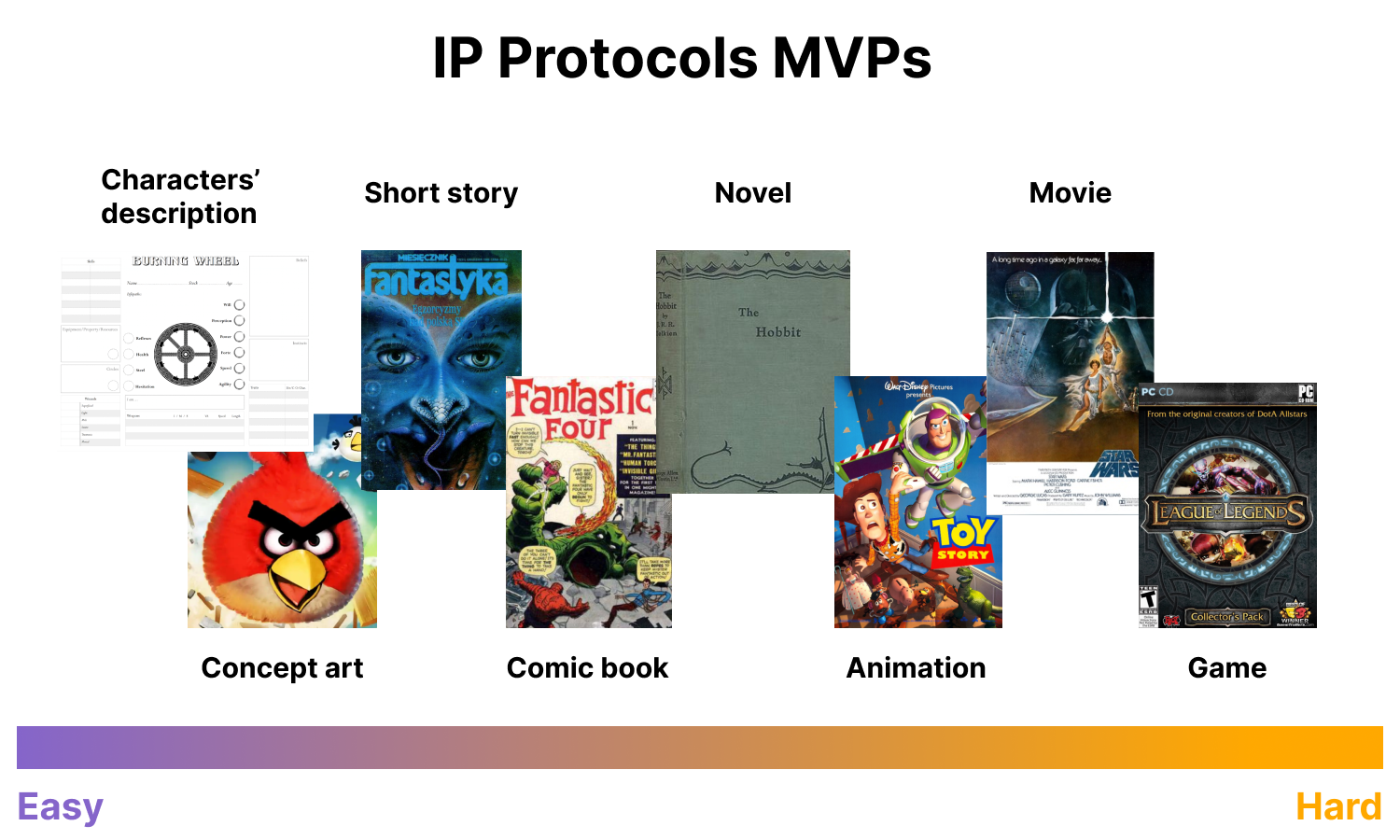
Step 4: Facilitate other MVPs & fan-created worlds,
So we built our first MVP. What’s next?
When we answered why Ethereum is permissionless, the main reason was that it lets people build valuable apps on top of it. So Step 4 is to encourage people to populate the world with their apps - stories, movies, and concept arts. We could call it a fan-created world.
By fan-created worlds, of course, we don’t mean design by committee where the artistic vision - to its demise - is crafted through the democratic process. We mean design by a thousand individuals where everyone can build whatever they want if they follow the IP protocol’s guidelines.
How to do it? Blockchains typically tackle it in three main ways.
First of all, they help curious hackers to build things on top of their protocols. So they run workshops, answer their questions and resolve any ambiguities in the documentation.
They also facilitate the protocol’s community by organizing conferences & hackathons where developers can meet and build things together.
And on top of that, they run ecosystem funds that distribute grants to the best developers so they can focus on building apps full-time without having to think about paying their rent.
How to do it as an IP Protocol? The most obvious path is to follow the blockchains’ steps.
The writer could help creators with “documentation”, which in his case are the guiding rules and the bigger vision of the world and characters he created.
He could also set up a fund that sponsors creative workshops, meet-ups, and conferences for his community.
And the money to cover these expenses would be raised via the NFT collection depicting characters from his short story and then distributed via grants to other writers, comic book artists, and animators.
Another way for more established writers would be to share “status grants”. Imagine you’re a fan of J.K. Rowling, and she publicly praises your Harry Potter fan fiction - it would have been great, right? And this seal of approval could also open many doors.
To not fulfill Disney’s nightmares of crap flooding the audience's attention, we could draw the idea from AppStore. The Universe author could pick his favorite creations and publish them on his website. It could be supplemented by an overview of other works with community-generated 5-star ratings of different pieces of content. The audience could also use filters and search to find the things they find the most interesting.
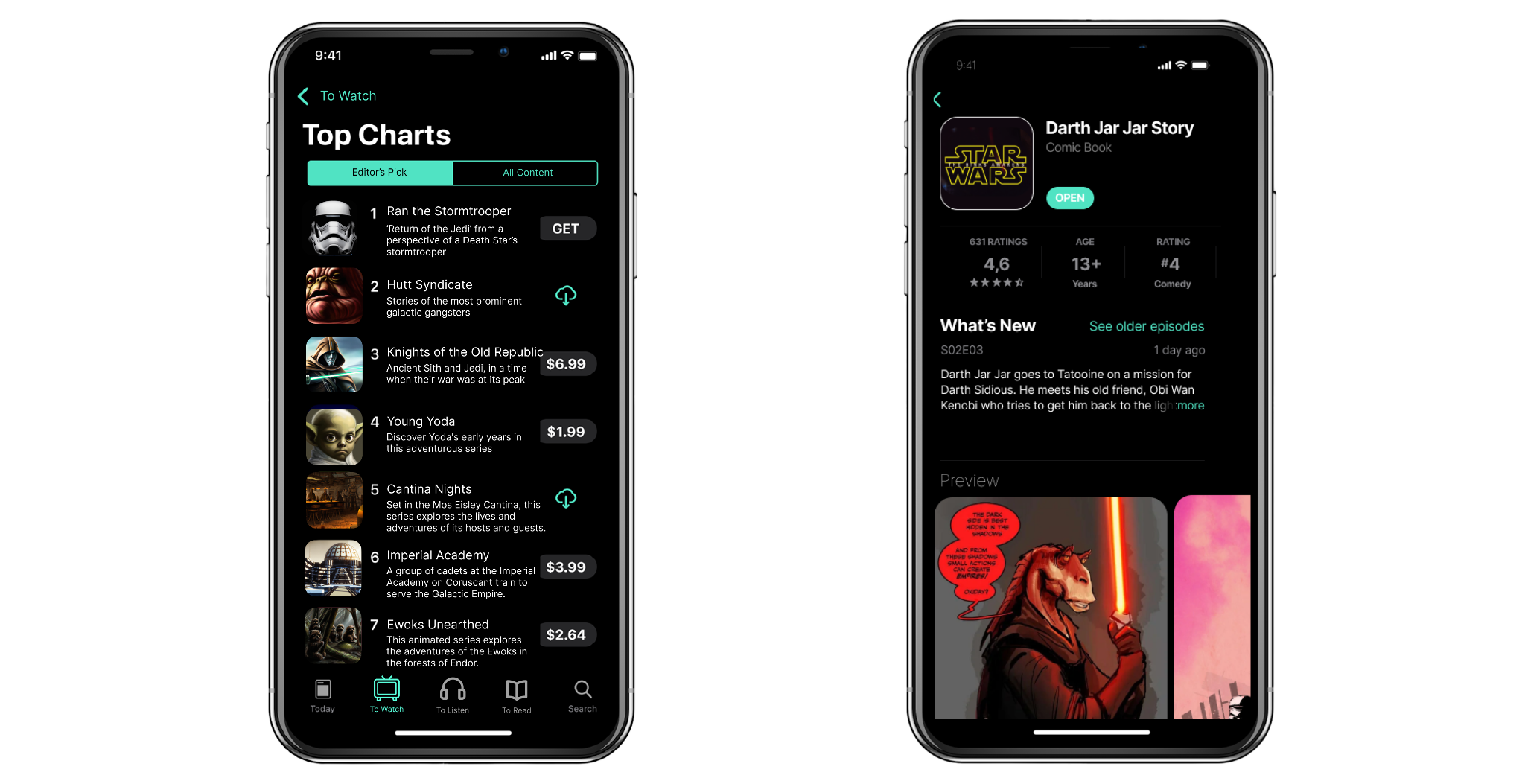
Instead of searching for apps, we would search for content related to worlds like “Star Wars”
But why would anyone build on top of your world instead of building their own? It’s much easier to build your own world than build your own blockchain, so it’s a fair question. The caveat is that your Universe MVP needs to be moving enough to inspire people to create their own pieces. No one would care about the Star Wars Universe if the first movie was a flop.
But there are also other ways to give people an extra push.
Step 5: Monetization
One of the hardest things about opening your world is monetization.
Here’s the cautionary tale from G.R.R. Martin:
Let me bring up a couple other writers, then. Contemporaries of an earlier age, each of whom was known by a set of initials: ERB and HPL. ERB created Tarzan and John Carter of Mars. HPL created Cthulhu and his Mythos. ERB, and later his estate, was extremely protective of his creations. Try to use Tarzan, or even an ape man who was suspiciously similar to Tarzan, without his/ their permission, and their lawyers would famously descend on you like a ton of bricks. HPL was the complete opposite.
The Cthulhu Mythos soon turned into one of our genres first shared worlds. HPL encouraged writer friends like Robert Bloch and Clark Ashton Smith to borrow elements from his Cuthulhu Mythos, and to add elements as well, which HPL himself would borrow in turn. And in time, other writers who were NOT friends of HPL also began to write Cthulhu Mythos stories, which continues to this day.
Fair enough. Two writers, two different decisions.
Thing is, ERB died a millionaire many times over, living on a gigantic ranch in a town that was named Tarzana after his creation. HPL lived and died in genteel poverty, and some biographers have suggested that poor diet brought on by poverty may have hastened his death. HPL was a far more beloved figure amongst other writers, but love will only get you so far. Sometimes it's nice to be able to have a steak too.
The Burroughs estate was paid handsomely for every Tarzan movie ever made, and collected plenty on the PRINCESS OF MARS movie I worked on during my Hollywood years, and no doubt is still collecting on the one currently in development... though the book is in the public domain by now. Did the Lovecraft estate make a penny off THE DUNWICH HORROR movie, the HERBERT WEST, REANIMATOR movie, the recent DAGON movie, the internet version of CALL OF CTHULHU? I don't know. I rather doubt it. If they did, I'll betcha it was just chump change.
Meanwhile, new writers go right on mining the Cthulhu mythos, writing new stories and novels.
So how could we ensure that our author doesn’t die as a poor man? One of the answers might be NFTs.
Let’s imagine H.P. Lovecraft printed 10,000 collectible cards with the characters from his novels, sold 9,500 of them, and kept 500. If the Cthulu Universe got more popular, the value of the #1 edition collectible cards would go up. And although collectible cards seem trivial, their valuations might reach millions of dollars.
Lovecraft, as an author of the world, would also be able to print expansion packs and other materials to give hungry collectors even more collectibles. Since NFTs can take the form of digital collectibles, I believe this is how the authors can capture the value their world has generated.
These NFTs could also serve as a key to a closed community of the biggest Universe aficionados. They could also give you more power over the plot, just like NFTs in my experimental IP Protocols project “Cael Mux”. NFTs also play another important role in incentivizing their holders to grow & promote the Universe. It’s a positive sum game because the more popular the Universe, the more valuable their cards become.
We have already seen that happening among NFT collections like BAYC, Checks, or Nouns.
We could also employ more complex models, like the one where holding an NFT gives you rights to a percentage of royalties generated by this piece. This model has already been tested by Royal.io, where you can buy a piece of a music song and get % of the streaming
revenue. It has also been tested by Netflix, though without NFTs - fans can create their own Stranger Things merch and sell it if they give Netflix their cut.
NFTs might also be used to fund more ambitious and expensive projects like shooting a movie or an animation.
Tokens fundraising has been used by Emily Segal to raise $50k for her novel via Mirror. And - without using crypto at all - by Roberts Space Industries to raise over $500M+ to build a game called Star Citizen. To give you a perspective - Avengers: Infinity War had a 40% smaller budget of $325M.
To sum up, NFTs might not only help the author monetize their creation but also encourage other creators to build on top of their world.
Step 6: Adapting the Universe Protocol to AI-generated content
In the last few years, we’ve observed rapid growth in AI capabilities, so it would be unwise to ignore its impact.
Most people agree that in the future creative content will be at least partially AI-generated. So the next logical step for our worlds would be to make our Universe Protocol compatible with modern AI generators.
Since AI algorithms’ output is defined by their inputs, we would need to carefully test if descriptions of characters, worlds & guiding rules provide satisfactory AI content. The good thing about protocols is that they need to be - by definition - very clear. So if we precisely define the rules of our world, how the characters look, what’s the genre, and the main story arc, AI should be able to understand it.
We could probably even create specialized software using an AI model in the background to make this testing more user-friendly. Then we could share access to our prompts in the form of IP Protocol rules and characters so that everyone can create their own version of the story and fork it to their needs. Imagine creating Stranger Things or Star Wars with your friends in the main roles.
Seems absurd? I have already experienced this model in practice.
A few months ago, I went for a bi-annual trip with my buddies, and we had an RPG session placed in 1930s Warsaw.
Everyone got their RPG character with a captivating backstory and motives. The plot was multi-layered, and we had tons of locations to explore, each of them precisely reflecting real places from a century ago. It was tons of fun - we spent 8 hours playing and still explored maybe 30% of the world.
After we finished, our GM told us that 90% of that was prepared by GPT-4.
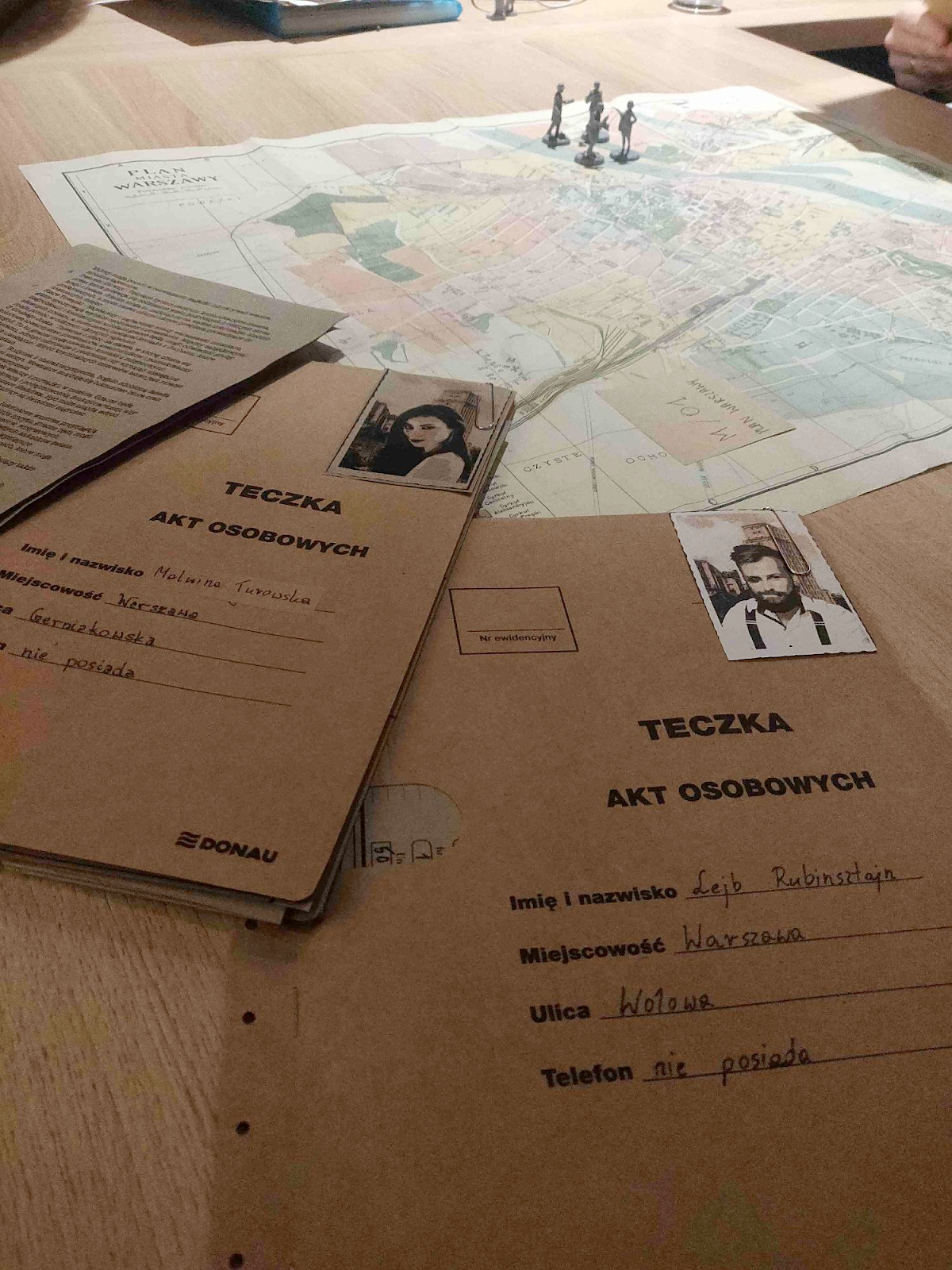
GM also edited real players' pictures to match the times - mine on the right, I was a poor Jewish ex-boxer working for detectives. And every single character in the game was inspired by our friends - both in terms of pictures and their traits. This customization made the game much more compelling.
Summary
As I promised at the start of this text, the IP Protocol’s rabbit hole is pretty deep. It starts with a seemingly innocent analogy and takes us on a ride through all implications that this analogy creates.
I believe creating permissionless IP Protocols is the future since agile free markets generate tighter feedback loops and - as a consequence - better products than centrally planned economies. And at this point, we still live in the centrally planned, waterfall economy stage of fiction.
Also, as the Open Source saying goes: “No matter who you are, most of the smartest people in the world don’t work for you”. Even as big a studio as Disney can’t hire all the best people, just like Google can’t hire all the best engineers.
I believe the world of fiction will go through the same transformation as the world of non-fiction, where user-generated blogs, Substacks, podcasts, and YouTube channels dominated the market.
Of course, I don’t expect big studios to follow this path. They - just like newspapers and TV stations in the early 2000s - have profitable and predictable business models, and changing them might be too risky. I also don’t think that the model I described will fully disrupt them - I think it will serve as an interesting and growing alternative.
I also don’t expect established authors to follow this path. As G.R.R. Martin said, opening your world might have its downsides and might end up not being really profitable. That’s why I count on emerging creators who have nothing to lose. Just like the biggest stars on TikTok are not the same people who dominated Instagram, I think the best creators of Open Universes won’t be the same ones who dominated closed ones.
That’s why I invite you to experiment with my ideas, fork them and create worlds that will surprise, entertain and inspire the next generation of humans.
To walk the talk, I’ve been doing it myself by writing a serialized cyberpunk novel. You can read it here, and if you like it, you can even mint the NFT to vote on the main character's decisions.
So write, draw, design, film, animate, and let’s create something remarkable together!
PS1: You can collect this post by clicking the button below.
PS2: And if you don't want to miss my next posts, subscribe!
PS3: Darth Jar Jar pics have been taken from here and here. AppStore UI has been taken from here.
- Loading comments...
